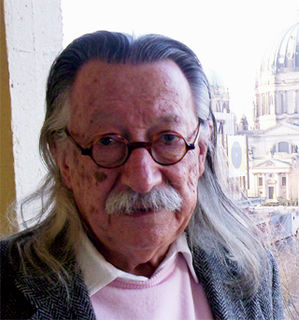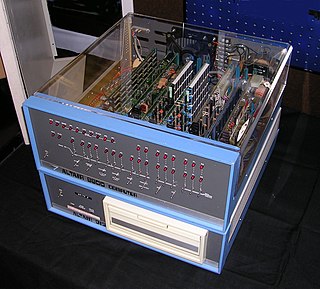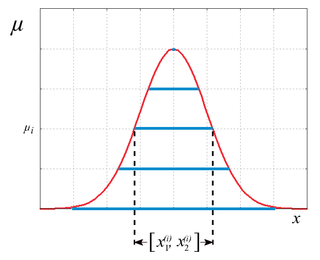Related Research Articles

An electronic calculator is typically a portable electronic device used to perform calculations, ranging from basic arithmetic to complex mathematics.

ELIZA is an early natural language processing computer program created from 1964 to 1966 at the MIT Artificial Intelligence Laboratory by Joseph Weizenbaum. Created to demonstrate the superficiality of communication between humans and machines, Eliza simulated conversation by using a "pattern matching" and substitution methodology that gave users an illusion of understanding on the part of the program, but had no built in framework for contextualizing events. Directives on how to interact were provided by "scripts", written originally in MAD-Slip, which allowed ELIZA to process user inputs and engage in discourse following the rules and directions of the script. The most famous script, DOCTOR, simulated a Rogerian psychotherapist, and used rules, dictated in the script, to respond with non-directional questions to user inputs. As such, ELIZA was one of the first chatterbots and one of the first programs capable of attempting the Turing test.

Joseph Weizenbaum was a German American computer scientist and a professor at MIT. The Weizenbaum Award is named after him. He is considered one of the fathers of modern artificial intelligence.

The Pentium FDIV bug is a hardware bug affecting the floating-point unit (FPU) of the early Intel Pentium processors. Because of the bug, the processor would return incorrect binary floating point results when dividing certain pairs of high-precision numbers. The bug was discovered in 1994 by Thomas R. Nicely, a professor of mathematics at Lynchburg College. Missing values in a lookup table used by the FPU's floating-point division algorithm led to calculations acquiring small errors. While these errors would in most use-cases only occur rarely and result in small deviations from the correct output values, in certain circumstances the errors can occur frequently and lead to more significant deviations.
A fuzzy control system is a control system based on fuzzy logic—a mathematical system that analyzes analog input values in terms of logical variables that take on continuous values between 0 and 1, in contrast to classical or digital logic, which operates on discrete values of either 1 or 0.
Fuzzy logic is a form of many-valued logic in which the truth value of variables may be any real number between 0 and 1. It is employed to handle the concept of partial truth, where the truth value may range between completely true and completely false. By contrast, in Boolean logic, the truth values of variables may only be the integer values 0 or 1.

A Connection Machine (CM) is a member of a series of massively parallel supercomputers that grew out of doctoral research on alternatives to the traditional von Neumann architecture of computers by Danny Hillis at Massachusetts Institute of Technology (MIT) in the early 1980s. Starting with CM-1, the machines were intended originally for applications in artificial intelligence (AI) and symbolic processing, but later versions found greater success in the field of computational science.

The Altair 8800 is a microcomputer designed in 1974 by MITS and based on the Intel 8080 CPU. Interest grew quickly after it was featured on the cover of the January 1975 issue of Popular Electronics and was sold by mail order through advertisements there, in Radio-Electronics, and in other hobbyist magazines. The Altair is widely recognized as the spark that ignited the microcomputer revolution as the first commercially successful personal computer. The computer bus designed for the Altair was to become a de facto standard in the form of the S-100 bus, and the first programming language for the machine was Microsoft's founding product, Altair BASIC.

Lotfi Aliasker Zadeh was a mathematician, computer scientist, electrical engineer, artificial intelligence researcher, and professor of computer science at the University of California, Berkeley. Zadeh is best known for proposing fuzzy mathematics, consisting of several fuzzy-related concepts: fuzzy sets, fuzzy logic, fuzzy algorithms, fuzzy semantics, fuzzy languages, fuzzy control, fuzzy systems, fuzzy probabilities, fuzzy events, and fuzzy information. Zadeh was a founding member of the Eurasian Academy.

The Yamaha DX7 is a synthesizer manufactured by the Yamaha Corporation from 1983 to 1989. It was the first successful digital synthesizer and is one of the best-selling synthesizers in history, selling more than 200,000 units.

The Duckworth–Lewis–Stern method (DLS) is a mathematical formulation designed to calculate the target score for the team batting second in a limited overs cricket match interrupted by weather or other circumstances. The method was devised by two English statisticians, Frank Duckworth and Tony Lewis, and was formerly known as the Duckworth–Lewis method (D/L). It was introduced in 1997, and adopted officially by the ICC in 1999. After the retirements of Duckworth and Lewis, Professor Steven Stern became the custodian of the method and it was renamed to its current title in November 2014.
A fuzzy associative matrix expresses fuzzy logic rules in tabular form. These rules usually take two variables as input, mapping cleanly to a two-dimensional matrix, although theoretically a matrix of any number of dimensions is possible. From the perspective of neuro-fuzzy systems, the mathematical matrix is called a "Fuzzy associative memory" because it stores the weights of the perceptron.

Joseph Amadee Goguen was an American computer scientist. He was professor of Computer Science at the University of California and University of Oxford, and held research positions at IBM and SRI International.

Larry Wayne "Chipper" Jones Jr. is an American former Major League Baseball (MLB) player and broadcast analyst, and current MLB consultant. Jones was the Atlanta Braves' number one overall pick in the 1990 MLB draft and their primary third baseman from 1995 to 2012. He was also a member of their 1995 World Series championship team that beat the Cleveland Indians. An eight-time All-Star, Jones won the 1999 National League (NL) Most Valuable Player Award and the 1999 and 2000 NL Silver Slugger Award for third basemen. He was the MLB batting champion in 2008 after hitting .364.
The 1927 Washington Senators won 85 games, lost 69, and finished in third place in the American League. They were managed by Bucky Harris and played home games at Griffith Stadium.

George Jiří Klir was a Czech-American computer scientist and professor of systems sciences at Binghamton University in Binghamton, New York.

Bat-Manga!: The Secret History of Batman in Japan is a 2008 book published by Pantheon Books, subsidiary of Random House, in the United States. The book was designed by Chip Kidd, the content was sourced from Saul Ferris’ extensive collection of Japanese Batman manga, toys and ephemera, which was photographed by frequent collaborator Geoff Spear. It collects a Japanese shōnen manga adaptation of the American comic book series Batman by Jiro Kuwata simply entitled Batman and also includes photographs of vintage Batman toys from Japan. The Batman manga included in Bat-Manga! was created during a Batman craze in Japan, being serialized from April 1966 to May 1967; the series ended when the craze ended. The manga was released in paperback and at the same time a limited hardcover was released on October 28, 2008, with an additional manhua bootleg and an extra Batman story by the creator. On October 28, 2013, the entire 53 chapter run of the series was released in Japan as a three volume-box set.

A fuzzy number is a generalization of a regular, real number in the sense that it does not refer to one single value but rather to a connected set of possible values, where each possible value has its own weight between 0 and 1. This weight is called the membership function. A fuzzy number is thus a special case of a convex, normalized fuzzy set of the real line. Just like Fuzzy logic is an extension of Boolean logic, fuzzy numbers are an extension of real numbers. Calculations with fuzzy numbers allow the incorporation of uncertainty on parameters, properties, geometry, initial conditions, etc. The arithmetic calculations on fuzzy numbers are implemented using fuzzy arithmetic operations, which can be done by two different approaches: (1) interval arithmetic approach; and (2) the extension principle approach.
Zeitgeist is a series of three documentary films released between 2007 and 2011 that present a number of conspiracy theories, as well as proposals for broad social and economic changes. The films, Zeitgeist: The Movie (2007), Zeitgeist: Addendum (2008) and Zeitgeist: Moving Forward (2011) are all directed by Peter Joseph.

Irvin Victor "Fuzzy" Hufft was an American professional baseball outfielder. He played in the Pacific Coast League for the Seattle Indians, Mission Reds, and Oakland Oaks from 1926 to 1932. He is a member of the PCL Hall of Fame.
References
- ↑ Bennett, Drake (January 28, 2011). "Innovator: Joseph Bates - BusinessWeek". Bloomberg Businessweek . Retrieved 30 January 2011.
- ↑ Hardesty, Larry (January 3, 2011). "The surprising usefulness of sloppy arithmetic". MIT News Office. Archived from the original on 29 January 2011. Retrieved 30 January 2011.